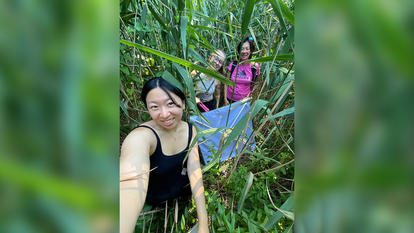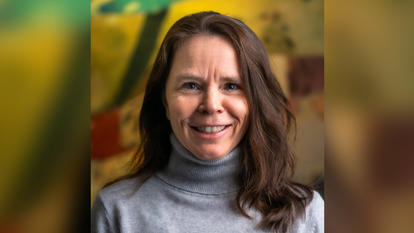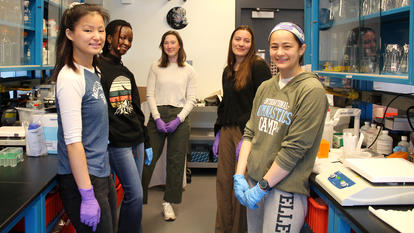Scientific Research at Wellesley: At Poster Session, Students Tell Their Summer Research Stories

Volts of creative thinking surged through Wellesley’s Science Center Library on July 27 as students talked about their research at a culminating poster session for Wellesley’s Summer Research Program, which gives a select group of students the opportunity to learn and study in an environment that is similar to graduate school. The nine-week program is funded by Wellesley.
This summer’s student researchers included 123 participants from Wellesley in addition to students from Clark University, Vassar College, and Bowdoin College, said Cathy Summa, director of Wellesley’s Science Center. “The students are energetic, motivated, and dedicated to their subjects of study,” she said.
Pamela Melroy ’83, a retired U.S. Air Force officer and former NASA astronaut who was the second woman to command a space shuttle mission, opened the event with a talk about the transformative experience of pursuing her education at Wellesley and her dreams of space travel.
“I wanted to explore,” she said. “I wanted to learn new things and anything that had to do with the sky. I valued my aspiration, and I was able to accomplish it here.” The Whitin Observatory, she said, became “the heart of the campus for me.”
In the audience for Melroy’s talk was Ananya Hariharan ’19, who participated in the research program this summer. A political science major, Hariharan is studying gender and racial diversity on the U.S. Circuit Court of Appeals with a focus on presidential appointments to the court from Jimmy Carter’s administration to the present.
“My goal is to see if each president since President Jimmy Carter has had a cohesive strategy to diversify the circuit courts as judges retire or resign or pass away,” she said. Part of the rationale for her work is that “federal appellate courts often see cases that debate whether laws are constitutional. Diversity is important.”
The bulk of the displays focused on the natural sciences, such as the effect of pollen shortages on bumblebees. Katie Burns ’18, a psychology major, explained the significance of bumblebee health. She was a member of a three-person team whose project was titled “Investigating the Effect of Developmental Pollen Stress on Adult Behavior in Bumblebees.”
“Bumblebees can be a barometer on how we treat our environment,” she said. “Lack of pollen, which is a natural resource for them, is problematic. We can take them for granted, but we can learn a lot from them.”
Students also displayed work in other areas. Emma Lurie ’19, a computer science major and a self-described news junkie, talked about her research on “fake news.” Her poster listed three questions she said news readers should ask themselves: Has the story been fact-checked? Where do external links go? Who else is reporting this story?
“The public needs to know how to interact with the web and how to verify information, because unfortunately people believe what they read,” said Lurie.
Attendees at the poster session also included incoming students, such as Abigail Parakoyi ’21. Parakoyi was selected by the Posse Foundation, a national organization for college access and youth leadership development programs, to participate in summer research at Wellesley. The Posse Foundation has partnered with Wellesley and other selective colleges and universities to increase enrollment of students from underrepresented groups in science, technology, engineering, and math fields. Her presentation outlined the foundation’s goals and included a list of students who will be joining her as first-years at Wellesley.
Parakoyi chose Wellesley over her other options, she said, because of the student-professor ratio, including in the STEM fields. “I visited and I felt welcome, and everyone seemed to be enthusiastic,” she said. “My focus is neuroscience. I want to be a doctor, a scientist. Wellesley will help me get there.”



